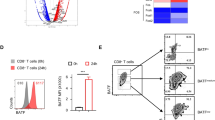Abstract
We have previously demonstrated that indoleamine 2,3-dioxygenase (IDO) expression by skin cells generates a tryptophan deficient environment in which THP-1, Jurkat cells as well as human PBMC are unable to survive. However, the subsets of primary human T cells that are sensitive to tryptophan depletion have not been identified. In this study, we asked whether the proliferation and viability of bystander CD4+ and CD8+ T cells are modulated in response to IDO induced tryptophan deficient environment and if so, whether their response is different. To address these questions, we co-cultured IDO-expressing fibroblasts with bystander human CD4+ and CD8+ T cells for 4 days and then the survival and proliferation rates as well as downstream metabolic pathway of tryptophan degradation in these cells were evaluated. The results showed a marked immunosuppressive effect of IDO expression on both subsets of primary human T cells. Interestingly, there was also a significant difference in the suppressive effect of IDO on proliferation of CD8+ compared to that of CD4+ T cells. The results of subsequent experiments showed that this discrepancy is due to differences in GCN2 kinase pathway activation between these two sets of immune cells. In conclusion, the finding of this study revealed that the proliferation of CD8+ and CD4+ T cells are suppressed in response to tryptophan deficient environment caused by IDO expression and it is more so for CD8+ T than CD4+ T cells.




Similar content being viewed by others
Abbreviations
- CHOP:
-
CCAAT/enhancer-binding protein homologous protein
- 1MT:
-
1-Methyl-d-Tryptophan
- 7-AAD:
-
7-Amino-Actinomycin
References
Terness P, Bauer TM, Rose L, Dufter C, Watzlik A, Simon H, Opelz G (2002) Inhibition of allogeneic T-cell proliferation by indoleamine 2,3-dioxygenase-expressing dendritic cells: mediation of suppression by tryptophan metabolites. J Exp Med 196:447–457
Allen JB, Wong HL, Costa GL, Bienkowski MJ, Wahl SM (1993) Suppression of monocyte function and differential regulation of IL-1 and IL-1ra by IL-4 contribute to resolution of experimental arthritis. J Immunol 151:4344–4351
Ignotz RA, Massague J (1986) Transforming growth factor-beta stimulates the expression of fibronectin and collagen and their incorporation into the extracellular matrix. J Biol Chem 261:4337–4345
Jalili RB GAGALYTE 2005 Indoleamine 2,3-dioxygenase (IDO): its immunoregulatory role in the physiology and pathology of the body. Kerala, India: Research Signpost 49–67
Sporn MB, Roberts AB, Wakefield LM, de CB (1987) Some recent advances in the chemistry and biology of transforming growth factor-beta. J Cell Biol 105:1039–1045
Munn DH, Shafizadeh E, Attwood JT, Bondarev I, Pashine A, Mellor AL (1999) Inhibition of T cell proliferation by macrophage tryptophan catabolism. J Exp Med 189:1363–1372
Munn DH, Sharma MD, Baban B, Harding HP, Zhang Y, Ron D, Mellor AL (2005) GCN2 kinase in T cells mediates proliferative arrest and anergy induction in response to indoleamine 2,3-dioxygenase. Immunity 22:633–642
Ghahary A, Li Y, Tredget EE, Kilani RT, Iwashina T, Karami A, Lin X (2004) Expression of indoleamine 2,3-dioxygenase in dermal fibroblasts functions as a local immunosuppressive factor. J Invest Dermatol 122:953–964
Jalili RB, Rayat GR, Rajotte RV, Ghahary A (2007) Suppression of islet allogeneic immune response by indoleamine 2,3- dioxygenase-expressing fibroblasts. J Cellular Physiology 213:137–143
Li Y, Tredget EE, Ghaffari A, Lin X, Kilani RT, Ghahary A (2006) Local expression of indoleamine 2,3-dioxygenase protects engraftment of xenogeneic skin substitute. J Invest Dermatol 126:128–136
Fallarino F, Grohmann U, Vacca C, Bianchi R, Orabona C, Spreca A, Fioretti MC, Puccetti P (2002) T cell apoptosis by tryptophan catabolism. Cell Death Differ 9:1069–1077
Munn DH, Sharma MD, Hou D, Baban B, Lee JR, Antonia SJ, Messina JL, Chandler P, Koni PA, Mellor AL (2004) Expression of indoleamine 2,3-dioxygenase by plasmacytoid dendritic cells in tumor-draining lymph nodes. J Clin Invest 114:280–290
Wek RC, Jiang HY, Anthony TG (2006) Coping with stress: eIF2 kinases and translational control. Biochem Soc Trans 34:7–11
Acknowledgments
The Canadian Institutes of Health Research and British Columbia Professional Fire Fighters’ Burn Fund supported this study. Farshad Forouzandeh and Reza B. Jalili are holding University Graduate Fellowships from the University of British Columbia. Marc Germain is the recipient of a Postdoctoral Fellowship from the Michael Smith Foundation for Health Research. The authors are grateful to Dr. JM Carlin (Department of Microbiology, Miami University, Oxford, OH) for his gift of IDO cDNA.
Author information
Authors and Affiliations
Corresponding author
Rights and permissions
About this article
Cite this article
Forouzandeh, F., Jalili, R.B., Germain, M. et al. Differential immunosuppressive effect of indoleamine 2,3-dioxygenase (IDO) on primary human CD4+ and CD8+ T cells. Mol Cell Biochem 309, 1–7 (2008). https://doi.org/10.1007/s11010-007-9635-y
Received:
Accepted:
Published:
Issue Date:
DOI: https://doi.org/10.1007/s11010-007-9635-y




